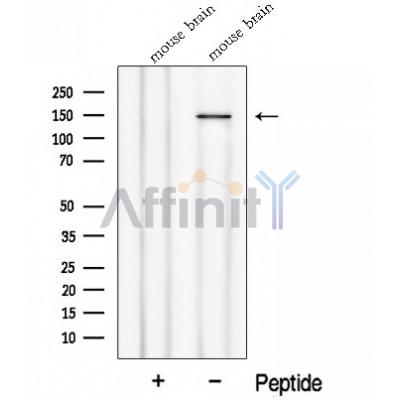NPHP4 Antibody - #DF12675
| Product: | NPHP4 Antibody |
| Catalog: | DF12675 |
| Description: | Rabbit polyclonal antibody to NPHP4 |
| Application: | WB |
| Reactivity: | Human, Mouse, Dog |
| Prediction: | Bovine |
| Mol.Wt.: | 150 kDa; 158kD(Calculated). |
| Uniprot: | O75161 |
| RRID: | AB_2845637 |
Related Downloads
Protocols
Product Info
*The optimal dilutions should be determined by the end user. For optimal experimental results, antibody reuse is not recommended.
*Tips:
WB: For western blot detection of denatured protein samples. IHC: For immunohistochemical detection of paraffin sections (IHC-p) or frozen sections (IHC-f) of tissue samples. IF/ICC: For immunofluorescence detection of cell samples. ELISA(peptide): For ELISA detection of antigenic peptide.
Cite Format: Affinity Biosciences Cat# DF12675, RRID:AB_2845637.
Fold/Unfold
KIAA0673; Nephrocystin-4; nephronophthisis 4; Nephroretinin; NPHP4; NPHP4_HUMAN; POC10; POC10 centriolar protein homolog; SLSN4;
Immunogens
A synthesized peptide derived from human NPHP4, corresponding to a region within the internal amino acids.
Expressed in kidney, skeletal muscle, heart and liver, and to a lesser extent in brain and lung.
- O75161 NPHP4_HUMAN:
- Protein BLAST With
- NCBI/
- ExPASy/
- Uniprot
MNDWHRIFTQNVLVPPHPQRARQPWKESTAFQCVLKWLDGPVIRQGVLEVLSEVECHLRVSFFDVTYRHFFGRTWKTTVKPTKRPPSRIVFNEPLYFHTSLNHPHIVAVVEVVAEGKKRDGSLQTLSCGFGILRIFSNQPDSPISASQDKRLRLYHGTPRALLHPLLQDPAEQNRHMTLIENCSLQYTLKPHPALEPAFHLLPENLLVSGLQQIPGLLPAHGESGDALRKPRLQKPITGHLDDLFFTLYPSLEKFEEELLELHVQDHFQEGCGPLDGGALEILERRLRVGVHNGLGFVQRPQVVVLVPEMDVALTRSASFSRKVVSSSKTSSGSQALVLRSRLRLPEMVGHPAFAVIFQLEYVFSSPAGVDGNAASVTSLSNLACMHMVRWAVWNPLLEADSGRVTLPLQGGIQPNPSHCLVYKVPSASMSSEEVKQVESGTLRFQFSLGSEEHLDAPTEPVSGPKVERRPSRKPPTSPSSPPAPVPRVLAAPQNSPVGPGLSISQLAASPRSPTQHCLARPTSQLPHGSQASPAQAQEFPLEAGISHLEADLSQTSLVLETSIAEQLQELPFTPLHAPIVVGTQTRSSAGQPSRASMVLLQSSGFPEILDANKQPAEAVSATEPVTFNPQKEESDCLQSNEMVLQFLAFSRVAQDCRGTSWPKTVYFTFQFYRFPPATTPRLQLVQLDEAGQPSSGALTHILVPVSRDGTFDAGSPGFQLRYMVGPGFLKPGERRCFARYLAVQTLQIDVWDGDSLLLIGSAAVQMKHLLRQGRPAVQASHELEVVATEYEQDNMVVSGDMLGFGRVKPIGVHSVVKGRLHLTLANVGHPCEQKVRGCSTLPPSRSRVISNDGASRFSGGSLLTTGSSRRKHVVQAQKLADVDSELAAMLLTHARQGKGPQDVSRESDATRRRKLERMRSVRLQEAGGDLGRRGTSVLAQQSVRTQHLRDLQVIAAYRERTKAESIASLLSLAITTEHTLHATLGVAEFFEFVLKNPHNTQHTVTVEIDNPELSVIVDSQEWRDFKGAAGLHTPVEEDMFHLRGSLAPQLYLRPHETAHVPFKFQSFSAGQLAMVQASPGLSNEKGMDAVSPWKSSAVPTKHAKVLFRASGGKPIAVLCLTVELQPHVVDQVFRFYHPELSFLKKAIRLPPWHTFPGAPVGMLGEDPPVHVRCSDPNVICETQNVGPGEPRDIFLKVASGPSPEIKDFFVIIYSDRWLATPTQTWQVYLHSLQRVDVSCVAGQLTRLSLVLRGTQTVRKVRAFTSHPQELKTDPKGVFVLPPRGVQDLHVGVRPLRAGSRFVHLNLVDVDCHQLVASWLVCLCCRQPLISKAFEIMLAAGEGKGVNKRITYTNPYPSRRTFHLHSDHPELLRFREDSFQVGGGETYTIGLQFAPSQRVGEEEILIYINDHEDKNEEAFCVKVIYQ
Predictions
Score>80(red) has high confidence and is suggested to be used for WB detection. *The prediction model is mainly based on the alignment of immunogen sequences, the results are for reference only, not as the basis of quality assurance.
High(score>80) Medium(80>score>50) Low(score<50) No confidence
Research Backgrounds
Involved in the organization of apical junctions; the function is proposed to implicate a NPHP1-4-8 module. Does not seem to be strictly required for ciliogenesis. Required for building functional cilia. Involved in the organization of the subapical actin network in multiciliated epithelial cells. Seems to recruit INT to basal bodies of motile cilia which subsequently interacts with actin-modifying proteins such as DAAM1 (By similarity). In cooperation with INVS may downregulate the canonical Wnt pathway and promote the Wnt-PCP pathway by regulating expression and subcellular location of disheveled proteins. Stabilizes protein levels of JADE1 and promotes its translocation to the nucleus leading to cooperative inhibition of canonical Wnt signaling. Acts as negative regulator of the hippo pathway by association with LATS1 and modifying LATS1-dependent phosphorylation and localization of WWTR1/TAZ.
Cytoplasm>Cytoskeleton>Cilium basal body. Cytoplasm>Cytoskeleton>Microtubule organizing center>Centrosome. Cell junction>Tight junction. Nucleus.
Note: In cultured renal cells, it localizes diffusely in the cytoplasm but, as cells approach confluence, it accumulates to basolateral tight junctions (By similarity). Localizes to the ciliary transition zone (By similarity). In the retinal photoreceptor cell layer, localizes at the connecting cilium (By similarity).
Expressed in kidney, skeletal muscle, heart and liver, and to a lesser extent in brain and lung.
Belongs to the NPHP4 family.
Restrictive clause
Affinity Biosciences tests all products strictly. Citations are provided as a resource for additional applications that have not been validated by Affinity Biosciences. Please choose the appropriate format for each application and consult Materials and Methods sections for additional details about the use of any product in these publications.
For Research Use Only.
Not for use in diagnostic or therapeutic procedures. Not for resale. Not for distribution without written consent. Affinity Biosciences will not be held responsible for patent infringement or other violations that may occur with the use of our products. Affinity Biosciences, Affinity Biosciences Logo and all other trademarks are the property of Affinity Biosciences LTD.

